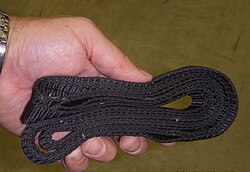
A strap, sometimes also called strop, is an elongated flap or ribbon, usually of leather or other flexible materials.
Contents
Thin straps are used as part of clothing or baggage, or bedding such as a sleeping bag. See for example spaghetti strap, shoulder strap. A strap differs from a belt mainly in that a strap is usually integral to the item of clothing; either can be used in combination with buckles.
Straps are also used as fasteners to attach, secure, carry, or bind items, to objects, animals (for example a saddle on a horse) and people (for example a watch on a wrist), or even to tie down people and animals, as on an apparatus for corporal punishment. Occasionally a strap is specified after what it binds or holds, e.g. chin strap. Webbing is a particular type of strap that is a strong fabric woven as a flat strip or tube that is also often used in place of rope. Modern webbing is typically made from exceptionally high-strength material and is used in automobile seat belts, furniture manufacturing, transportation, towing, military uniform, cargo fasteners, and many other fields.


